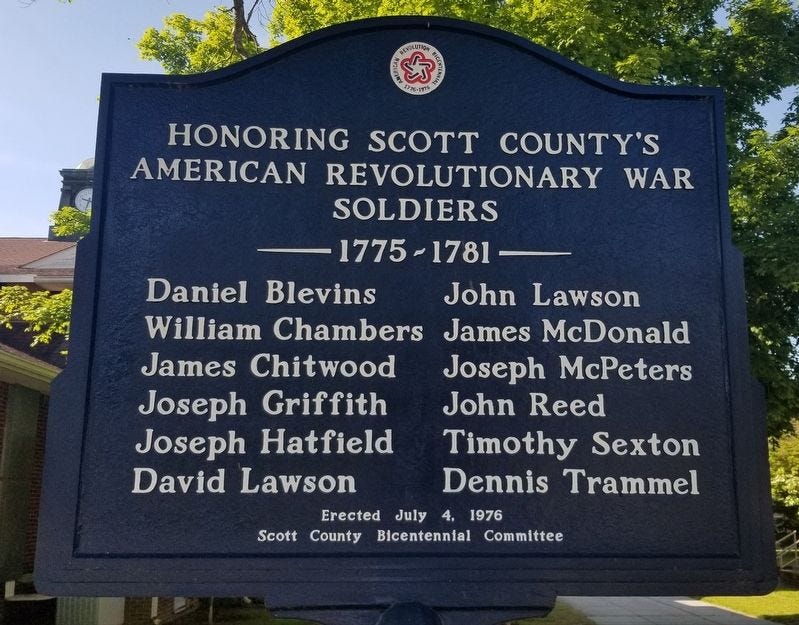The three Lawson brothers who fought in the Revolutionary War and then moved to Scott County
Brothers Randolph, John and David were born in Virginia, moved to North Carolina and served as militiamen during the war for independence, then moved to present-day Scott County.
You’re reading “Echoes in Time,” a weekly newsletter by the Independent Heraldthat focuses on stories of years gone by in order to paint a portrait of Scott County and its people. “Echoes in Time” is one of six weekly newsletters published by the IH. You can adjust your subscription settings to include as many or as few of these newsletters as you want. If you aren’t a subscriber, please consider doing so. It’s free!
Today’s newsletter is sponsored by the Scott County Chamber of Commerce. Since 1954, the Scott County Chamber of Commerce has advocated for a strong community by supporting stronger infrastructure and leadership.
The Lawson Three: They fought, then they moved to Scott County to raise their families

Following the Revolutionary War, American civilization exploded into the territories west of the Appalachian Divide — including the Cumberland Plateau along the Tennessee-Kentucky border.
Scott County, Tenn. wasn’t formed until 1849. Prior to that, the remote upland territory between the Cumberland Mountains and the Big South Fork River was part of Campbell or Anderson counties, primarily, with parts also falling into Fentress and Morgan counties.
However, the earliest settlers of the land that would become Scott County can be traced back long before 1849, and there were thousands of them living here by the time the Tennessee General Assembly created a new county and named it for War of 1812 hero Gen. Winfield Scott.
Most of those earliest settlers were Revolutionary War veterans — some of them because they received land grants from North Carolina for their war service (the Tennessee territory was part of North Carolina until being granted statehood) and some of them simply because they were looking to get away from the “crowded” conditions in Virginia and North Carolina.
A plaque outside the old Scott County Courthouse in Huntsville lists 12 of these Revolutionary War veterans who called present-day Scott County their home (although most of them were dead by the time Scott County was actually formed in 1849). The plaque was dedicated in 1976 as part of America’s bicentennial celebration. There are at least two more names that should have been on that list, including Randolph Lawson.
The Lawson trio
The Lawson family was unique in that three brothers, all Revolutionary War veterans, made their way to Scott County in the years after the war was fought.
Randolph Lawson was probably the oldest, born about 1752. It’s not clear why he wasn’t included on the plaque in Huntsville, which did include both his brothers. He settled on Paint Rock Creek near where it empties into New River outside present-day Huntsville. Second oldest was John Lawson, born about 1755. He settled in southern Scott County. Finally came David Lawson, born about 1758.
The Lawson brothers were from Bedford, Va., the sons of Bartholomew Lawson and Susannah Simpkins. They were among about 15 children born to Bartholomew and Susannah, and they had two other brothers — Morman and William — who also fought in the war.
When the 1850 census was taken, there were 29 Lawsons living in Scott County.
David Lawson
Born in 1758, David Lawson was 22 years old when he joined the North Carolina militia in 1780. He served under Capt. Samuel Johnson and fought at the Battle of Cowpens before later serving as an Indian spy.
After the war, Lawson married Elizabeth Jeffers in present-day Hawkins County, Tenn. They moved to the Clear Fork area of Campbell County, then to present-day Scott County, where they settled in the Winona area and established the Lawson family that remains quite prominent in that community today. They had five children: Samuel (1802-1880), Serepta (1805-N/A), David William (1811-1880), Thomas (1812-N/A) and Jacob Lee (1824-1891).
David Lawson was living in Tennessee when he filed for a Revolutionary War pension in 1843. He and Elizabeth do not appear in Scott County when the 1850 census was taken.
However, Jacob Lee Lawson does appear in the 1850 census. He married Lavicy Ann “Vicy” Lewallen and they had at least 11 children (four of which had been born by the 1850 census). Vicy was the daughter of Joel Lewallen and Rachel Taylor of Robbins. Her uncle was John Lewallen, Scott County’s first sheriff. Most of the Lawsons in Scott County today can trace their lineage back to Jacob Lawson.
David Lawson died in 1852. His burial location is unknown.
John Lawson
Three years older than David, John Lawson also enlisted in the North Carolina militia in 1780. He was involved in the Battle of Guilford in 1781, and was discharged after Lord Charles Cornwallis surrendered at Yorktown in October of that same year. In an application for a war pension, Lawson states that he enlisted in the militia as a substitute for David Lawson, which may be a reference to his brother.
John Lawson married Anna “Anny” Lawson in 1775. She was his first cousin (the daughter of Jonas Lawson, a brother to Bartholomew Lawson). They had at least 10 children, and perhaps as many as 14. Among them were: Betsey, John, Joshua, Lydia, Patsey, Runnels, William, Staples, Melinda, all of whom are named in John Lawson’s application for a war pension.
The Lawsons were living in McMinn County, Tenn. when the 1830 census was taken, but were in Morgan County (present day Scott County) when John applied for a war pension in 1833.
John and Anna may have settled in the Cordell area like his brother, David. He died in 1838 and she died in 1844.
Randolph Lawson
It’s somewhat ironic that the Lawson brother we know the most about is the only one of the three that does not appear on the courthouse plaque in Huntsville.
Randolph Lawson was a member of the North Carolina militia, like his brothers, and fought in the Battle of Camden. He later re-entered the war for a second six-month tour.
Some sources indicate that Lawson was not directly involved in the Battle of Camden but instead guarded the militia’s luggage because of his young age. If that is true, he was not born in 1752 — and may have actually been the youngest of the three Lawson brothers who moved to Scott County after the war.
Adding to the confusion over his age: Randolph Lawson told a court late in life that he was born in Cumberland County, N.C. The Lawson family did not move from Virginia to North Carolina until the mid 1750s. While he also told the court that he was born in 1752, he may not have been born until 13 years later.
Lawson married Virginia native Susannah Cross in 1791 and they had at least seven children: Elizabeth, Catherine Lakey, Lucretia, Elisha, Maxwell, Thomas and Clary.
An 1826 court document shows that Lawson purchased five acres of land on Paint Rock Creek near Huntsville. His property was located near the mouth of the Creek, next to New River. However, he likely moved to present-day Scott County much earlier than that. He is listed as a chainman on a New River property deed filed by fellow Revolutionary War veteran Abraham Goad in 1808.
One of Lawson’s daughters, Catherine Lakey “Katie” Lawson, married Thomas Chambers, the son of Revolutionary War veteran William Chambers, who also moved to present-day Scott County after the war. One of their eight children was Riley Chambers, who was elected Scott County’s first registrar in 1850 and served on the committee responsible for choosing Huntsville as the county seat.
Another of Lawson’s children, Elizabeth “Millie” Lawson, married Joseph Phillips. They had at least three children, one of which was Jehu Phillips, who served as Scott County Trustee for six years.
Unlike his brothers, Randolph Lawson did not spend the rest of his life in Scott County. He left and moved to Clinton County, Ky., north of Jamestown, Tenn., sometime prior to 1840. In court testimony, he stated that he left this area in 1832. The family was on its way to Illinois, but he fell ill along the route, prompting them to stop in Clinton County. He appears to have died in Albany, Ky. in 1848. (It should be noted that it is not known where Randolph or Susannah, who died in 1844, are buried. At least one source states that Randolph was buried in Illinois, but it does not appear that he ever completed his journey to Illinois. There is a Lawson Cemetery in Albany, where one of their children is known to be buried.)
Like their parents, most of Randolph Lawson’s children left Scott County, with many of them heading west to Arkansas or Texas. One of them, Elisha, moved with his parents to Kentucky. The only two who remained were Katie and Millie. Katie settled on Buffalo Creek and Millie settled in the Bull Creek area.
The Lawson family today
Many Lawsons remain in Scott County today, and most of them can trace their lineage back to the Winona and Bull Creek communities south of Huntsville. The Lawson and Brown Cemetery at Cordell dates back to 1879 and contains nearly 100 burials, including Jacob Lee Lawson, the son of the Revolutionary War veteran who was the forefather of the Cordell community.
One of the Lawsons buried at the Lawson and Brown Cemetery is Mary Jane Lawson, who was murdered — along with her husband, William Harness — by her first husband’s brother, Berry Bowling. Bowling was later hanged by a lynch mob. She was the granddaughter of Jacob Lee Lawson and Vicy Lewallen, and great-granddaughter of Revolutionary War veteran David Lawson.
Thank you for reading. Our next newsletters will be Threads of Life on Wednesday and The Weekender Thursday evening. Want to update your subscription to add or subtract these newsletters? Do so here. Need to subscribe? Enter your email address below!
◼️ Monday morning: The Daybreaker (news & the week ahead)
◼️ Tuesday: Echoes in Time (stories of our history)
◼️ Wednesday: Threads of Life (obituaries)
◼️ Thursday evening: The Weekender (news & the weekend)
◼️ Friday: Friday Features (beyond the news)
◼️ Sunday: Varsity (a weekly sports recap)



